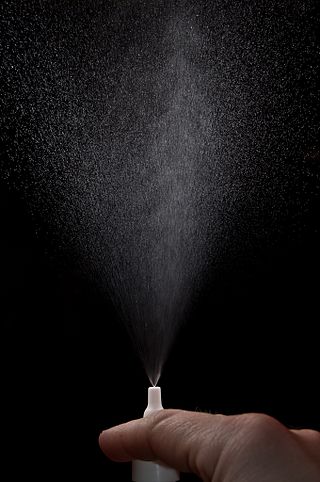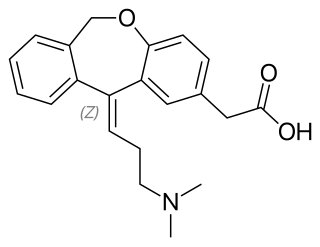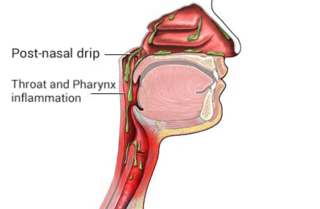Related Research Articles
An allergen is a type of antigen that produces an abnormally vigorous immune response in which the immune system fights off a perceived threat that would otherwise be harmless to the body. Such reactions are called allergies.

Allergic rhinitis, of which the seasonal type is called hay fever, is a type of inflammation in the nose that occurs when the immune system overreacts to allergens in the air. Signs and symptoms include a runny or stuffy nose, sneezing, red, itchy, and watery eyes, and swelling around the eyes. The fluid from the nose is usually clear. Symptom onset is often within minutes following allergen exposure, and can affect sleep and the ability to work or study. Some people may develop symptoms only during specific times of the year, often as a result of pollen exposure. Many people with allergic rhinitis also have asthma, allergic conjunctivitis, or atopic dermatitis.

Rhinitis, also known as coryza, is irritation and inflammation of the mucous membrane inside the nose. Common symptoms are a stuffy nose, runny nose, sneezing, and post-nasal drip.

Nasal sprays are used to deliver medications locally in the nasal cavities or systemically. They are used locally for conditions such as nasal congestion and allergic rhinitis. In some situations, the nasal delivery route is preferred for systemic therapy because it provides an agreeable alternative to injection or pills. Substances can be assimilated extremely quickly and directly through the nose. Many pharmaceutical drugs exist as nasal sprays for systemic administration. Other applications include hormone replacement therapy, treatment of Alzheimer's disease and Parkinson's disease. Nasal sprays are seen as a more efficient way of transporting drugs with potential use in crossing the blood–brain barrier.

Olopatadine, sold under the brand name Opatanol among others, is a medication used to decrease the symptoms of allergic conjunctivitis and allergic rhinitis. It is used as eye drops or as a nasal spray. The eye drops generally result in an improvement within half an hour.
Nasal congestion is the partial or complete blockage of nasal passages, leading to impaired nasal breathing, usually due to membranes lining the nose becoming swollen from inflammation of blood vessels.

Post-nasal drip (PND), also known as upper airway cough syndrome (UACS), occurs when excessive mucus is produced by the nasal mucosa. The excess mucus accumulates in the back of the nose, and eventually in the throat once it drips down the back of the throat. It can be caused by rhinitis, sinusitis, gastroesophageal reflux disease (GERD), or by a disorder of swallowing. Other causes can be allergy, cold, flu, and side effects from medications.

Rhinorrhea, rhinorrhoea, or informally runny nose is the free discharge of a thin mucus fluid from the nose; it is a common condition. It is a common symptom of allergies or certain viral infections, such as the common cold or COVID-19. It can be a side effect of crying, exposure to cold temperatures, cocaine abuse, or drug withdrawal, such as from methadone or other opioids. Treatment for rhinorrhea is not usually undertaken, but there are a number of medical treatments and preventive techniques.
Rhinitis medicamentosa is a condition of rebound nasal congestion suspected to be brought on by extended use of topical decongestants and certain oral medications that constrict blood vessels in the lining of the nose, although evidence has been contradictory.

Azelastine, sold under the brand name Optivar among others, is a H1 receptor-blocking medication primarily used as a nasal spray to treat allergic rhinitis (hay fever) and as eye drops for allergic conjunctivitis. Other uses may include asthma and skin rashes for which it is taken by mouth. Onset of effects is within minutes when used in the eyes and within an hour when used in the nose. Effects last for up to 12 hours.

Mometasone, also known as mometasone y 3 s, is a steroid medication used to treat certain skin conditions, hay fever, and asthma. Specifically it is used to prevent rather than treat asthma attacks. It can be applied to the skin, inhaled, or used in the nose. Mometasone furoate, not mometasone, is used in medical products.

Azatadine (Optimine) is a first-generation antihistamine and anticholinergic that was launched by Schering-Plough in 1973.
Chronic atrophic rhinitis, or simply atrophic rhinitis, is a chronic inflammation of the nose characterised by atrophy of nasal mucosa, including the glands, turbinate bones and the nerve elements supplying the nose. Chronic atrophic rhinitis may be primary and secondary. Special forms of chronic atrophic rhinitis are rhinitis sicca anterior and ozaena. It can also be described as the empty nose syndrome.

Metizoline is a nasal decongestant against allergic and vasomotor rhinitis.

Bilastine is an antihistamine medication used to treat hives (urticaria) and inflammation of the eye (allergic conjunctivitis) caused by an allergy. It is a second-generation antihistamine and takes effect by selectively inhibiting the histamine H1 receptor, preventing these allergic reactions. Bilastine has an effectiveness similar to cetirizine, fexofenadine, and desloratadine. It was originally developed in Spain by FAES Farma.

The allergic salute is the characteristic and sometimes habitual gesture of wiping and/or rubbing the nose in an upwards or transverse manner with the fingers, palm, or back of the hand. It is termed a salute because the upward movement of the hand acts as an unintentional gesture. The habit of using the hand to wipe the nose is observed more often in children but is common in adults as well. Saluting most commonly temporarily relieves nasal itching as well as removing small amounts of nasal mucus.
Gerd Rasp is a German physician of otorhinolaryngology with the additional specialties of plastic surgery and allergology. He is a professor and chairman of the hospital for otorhinolaryngology and dean for research affairs af the Paracelsus Private Medical University of Salzburg Austria. He is known for his work in the fields of rhinology and tympanic surgery.
Nonallergic rhinitis is rhinitis—inflammation of the inner part of the nose—not caused by an allergy. Nonallergic rhinitis displays symptoms including chronic sneezing or having a congested, drippy nose, without an identified allergic reaction. Other common terms for nonallergic rhinitis are vasomotor rhinitis and perennial rhinitis. The prevalence of nonallergic rhinitis in otolaryngology is 40%. Allergic rhinitis is more common than nonallergic rhinitis; however, both conditions have similar presentation, manifestation and treatment. Nasal itching and paroxysmal sneezing are usually associated with nonallergic rhinitis rather than allergic rhinitis.
Desloratadine/pseudoephedrine, sold under the brand name Clarinex-D among others, is a medication used for the treatment of seasonal allergic rhinitis.
Olopatadine/mometasone, sold under the brand name Ryaltris, is a fixed-dose combination medication for the treatment of allergic rhinitis and rhinoconjunctivitis in adults and adolescents twelve years of age and older. It contains olopatadine hydrochloride and mometasone furoate monohydrate. It is sprayed into the nose.